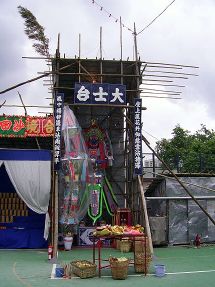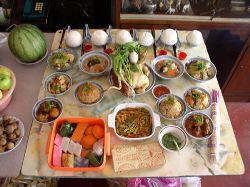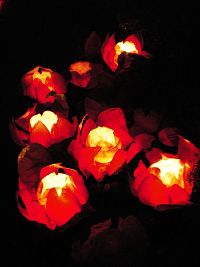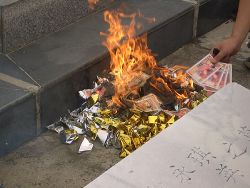Ghost Festival
| Ghost Festival | |
|---|---|

| |
| A paper effigy of the Ghost King in Shatin, Hong Kong | |
| Official name | Buddhism: Ullambana (TC: 盂蘭盆, SC: 盂兰盆 Yúlánpén) Taoism and Folk Belief: Zhōngyuán Jié (TC: 中元節, SC: 中元节) |
| Also called | Ghost Month |
| Observed by | Buddhists, Taoists, Chinese folk religion believers primarily in China, Vietnam, Taiwan, Korea, Japan, Singapore, Malaysia and Indonesia with related traditions and festivals observed in Cambodia, Laos, Sri Lanka and Thailand |
| Significance | The opening of the gates of Hell, permitting all ghosts to receive food and drink |
| Date | 15th night of the 7th Chinese month |
| Observances | Ancestor worship, offering food (to monks as well as deceased), burning joss paper, chanting of scriptures |
| Related to | Obon (in Japan) Baekjung (in Korea) Tết Trung Nguyên (in Vietnam) Pchum Ben (in Cambodia) Boun Khao Padap Din (in Laos) Mataka dānēs (in Sri Lanka) Sat Thai (in Thailand) |

The Ghost Festival, also known as the Hungry Ghost Festival, Zhongyuan Jie (中元節), Gui Jie (鬼節) or Yulan Festival (traditional Chinese: 盂蘭盆節; simplified Chinese: 盂兰盆节) is a traditional Buddhist and Taoist festival held in certain East Asian countries. According to the Chinese calendar (a lunisolar calendar), the Ghost Festival is on the 15th night of the seventh month (14th in parts of southern China).
In Chinese culture, the fifteenth day of the seventh month in the lunar calendar is called Ghost Day and the seventh month in general is regarded as the Ghost Month (鬼月), in which ghosts and spirits, including those of deceased ancestors, come out from the lower realm. Distinct from both the Qingming Festival (or Tomb Sweeping Day, in spring) and Double Ninth Festival (in autumn), in which living descendants pay homage to their deceased ancestors, during the Ghost Festival the deceased are believed to visit the living.
On the fifteenth day the realms of Heaven and Hell and the realm of the living are open and both Taoists and Buddhists would perform rituals to transmute and absolve the sufferings of the deceased. Intrinsic to the Ghost Month is veneration of the dead, where traditionally the filial piety of descendants extends to their ancestors even after their deaths. Activities during the month would include preparing ritualistic food offerings, burning incense, and burning joss paper, a papier-mâché form of material items such as clothes, gold and other fine goods for the visiting spirits of the ancestors. Elaborate meals (often vegetarian meals) would be served with empty seats for each of the deceased in the family treating the deceased as if they are still living. Ancestor worship is what distinguishes Qingming Festival from Ghost Festival because the latter includes paying respects to all deceased, including the same and younger generations, while the former only includes older generations. Other festivities may include, buying and releasing miniature paper boats and lanterns on water, which signifies giving directions to the lost ghosts and spirits of the ancestors and other deities.
Origins
The timing and origin story of the Ghost Festival ultimately derives from the Mahayana Buddhist scripture known as the Yulanpen or Ullambana Sutra. The sutra records the time when Maudgalyayana achieves abhijñā and uses his new found powers to search for his deceased parents. Maudgalyayana discovers that his deceased mother was reborn into the preta or hungry ghost realm. She was in a wasted condition and Maudgalyayana tried to help her by giving her a bowl of rice. Unfortunately as a preta, she was unable to eat the rice as it was transformed into burning coal. Maudgalyayana then asks the Buddha to help him; whereupon Buddha explains how one is able to assist one's current parents and deceased parents in this life and in one's past seven lives by willingly offering food to the sangha or monastic community during Pravarana (the end of the monsoon season or vassa), which usually occurs on the 15th day of the seventh month. The monastic community then transfers the merits to the deceased parents and seven previous generations as well as close relatives.[1]
The Theravadan forms of the festival in South and Southeast Asia (including Cambodia's Pchum Ben) are much older, deriving from the Petavatthu, a scripture in the Pali Canon that probably dates to the third century B.C.E.[2] The Petavatthu account is broadly similar to that later recorded in the Yulanpen Sutra, although it concerns the disciple Sāriputta and his family rather than Moggallāna.
Observance
According to the Chinese calendar (a lunisolar calendar), the Ghost Festival is on the fifteenth night of the seventh month. In parts of southern China the festival is held on the fourteenth night since, during the late Yuan to early Ming period, in order to escape the Yuan troops the Hakkas celebrated the Ghost Festival one day earlier.[3]
In Chinese culture, the fifteenth day of the seventh month in the lunar calendar is called Ghost Day and the seventh month in general is regarded as the Ghost Month (鬼月), in which ghosts and spirits, including those of deceased ancestors, come out from the lower realm. Distinct from both the Qingming Festival (or Tomb Sweeping Day, in spring) and Double Ninth Festival (in autumn) in which living descendants pay homage to their deceased ancestors, during Ghost Festival, the deceased are believed to visit the living.[4]
On the fifteenth day the realms of Heaven and Hell and the realm of the living are open and both Taoists and Buddhists would perform rituals to transmute and absolve the sufferings of the deceased. Intrinsic to the Ghost Month is veneration of the dead, where traditionally the filial piety of descendants extends to their ancestors even after their deaths. Activities during the month would include preparing ritualistic food offerings, burning incense, and burning joss paper, a papier-mâché form of material items such as clothes, gold and other fine goods for the visiting spirits of the ancestors. Elaborate meals (often vegetarian meals) would be served with empty seats for each of the deceased in the family treating the deceased as if they are still living. Ancestor worship is what distinguishes Qingming Festival from Ghost Festival because the latter includes paying respects to all deceased, including the same and younger generations, while the former only includes older generations. Other festivities may include, buying and releasing miniature paper boats and lanterns on water, which signifies giving directions to the lost ghosts and spirits of the ancestors and other deities.[5]
The Ghost Festival is held during the seventh month of the Chinese calendar. It also falls at the same time as a full moon, the new season, the fall harvest, the peak of Buddhist monastic asceticism, the rebirth of ancestors, and the assembly of the local community.[6] During this month, the gates of hell are opened up and ghosts are free to roam the earth where they seek food and entertainment. These ghosts are believed to be ancestors of those who forgot to pay tribute to them after they died, or those who were never given a proper ritual send-off. They have long needle-thin necks because they have not been fed by their family, or as a punishment so that they are unable to swallow. Family members offer prayers to their deceased relatives, offer food and drink and burn Joss paper money, also known as ghost money, and other items. Joss paper items are believed to have value in the afterlife, considered to be very similar in some aspects to the material world, People burn paper houses, cars, servants and televisions to please the ghosts.[7] Families also pay tribute to other unknown wandering ghosts so that these homeless souls do not intrude on their lives and bring misfortune. A large feast is held for the ghosts on the fourteenth day of the seventh month, when people bring samples of food and place them on an offering table to please the ghosts and ward off bad luck. Lotus-shaped lanterns are lit and set afloat in rivers and out onto seas to symbolicly guide the lost souls of forgotten ancestors to the afterlife.
In some East Asian countries today, live performances are held and everyone is invited to attend. The first row of seats are always empty as this is where the ghosts sit. The shows are always put on at night and at high volumes as the sound is believed to attract and please the ghosts. Some shows include Chinese opera, dramas, and in some areas, even burlesque shows. Traditionally Chinese opera was the main source of entertainment but the newer shows, concerts, dramas, wars and so forth are referred to as Getai.[8] These acts are better known as "Merry-making".[9]
For rituals, Buddhists and Taoists hold ceremonies to relieve ghosts from suffering, many of them holding ceremonies in the afternoon or at night (as it is believed that the ghosts are released from hell when the sun sets). Altars are built for the deceased and priests and monks alike perform rituals for the benefit of ghosts. Monks and priests often throw rice or other small foods into the air in all directions to distribute them to the ghosts.[9]
During the evening, incense is burnt in front of the doors households. Incense stands for prosperity in Chinese culture, so families believe that there is more prosperity in burning more incense.[9] During the festival, some shops are closed as they want to leave the streets open for the ghosts. In the middle of each street stands an altar of incense with fresh fruit and sacrifices displayed on it.[9]
Fourteen days after the festival, to make sure all the hungry ghosts find their way back to hell, people float water lanterns and set them outside their houses. These lanterns are made by setting a lotus flower-shaped lantern on a paper boat. The lanterns are used to direct the ghosts back to the underworld, and when they go out, it symbolizes that they have found their way back.[9]
Celebrations in other parts of Asia
Indonesia, Singapore and Malaysia
Concert-like performances are a prominent feature of the Ghost Festival in Singapore and Malaysia. Those live concerts are popularly known as Getai in Mandarin or Koh-tai in Hokkien Chinese.[10] They are performed by groups of singers, dancers, entertainers and opera troops or puppet shows on a temporary stage that is set up within a residential district. The festival is funded by the residents of each individual district. During these Getai the front row is left empty for the special guests—the ghosts.[11] It is known to be bad luck to sit on the front row of red seats, if anyone were to sit on them, they would become sick or similarly ailed.
In Singapore, people would pray to ghosts/spirits or ancestors with offerings & others outside their homes for the start of the 7th month. Most patriotic events were held on 7th Month for Singapore, which includes general and presidential elections, the Olympics and the National Day Parade. This is where the number of outings were minimised.
In Indonesia, the festival popularly known as Cioko, or Sembahyang Rebutan in Indonesian, (Scrambling prayer). People gather around temples and bring an offering to a spirit who died in an unlucky way, and after that, they distribute it to the poor. The way people scramble the offerings is the origin of the festival name.
Taiwan
Traditionally, it is believed that ghosts haunt the island of Taiwan for the entire seventh lunar month, when the mid-summer Ghost Festival is held.[12] The month is known as Ghost Month.[13] The first day of the month is marked by opening the gate of a temple, symbolizing the gates of hell. On the twelfth day, lamps on the main altar are lit. On the thirteenth day, a procession of lanterns is held. On the fourteenth day, a parade is held for releasing water lanterns. Incense and food are offered to the spirits to deter them from visiting homes and spirit paper money is also burnt as an offering.[14] During the month, people avoid surgery, buying cars, swimming, moving house, marrying, whistling and going out or taking pictures after dark. It is also important that addresses are not revealed to the ghosts.[citation needed]
Japan

Obon (sometimes transliterated O-bon), or simply Bon, is the Japanese version of the Ghost Festival. Obon is a shortened form of Ullambana (Japanese: 于蘭盆會 or 盂蘭盆會, urabon'e), a Sanskrit term meaning "hanging upside down," which implies great suffering.[15] The suffering of these spirits is ameliorated through the segaki ("feeding the hungry ghosts") ritual of Japanese Buddhism. This was traditionally performed to stop the suffering of the gaki or muenbotoke (the dead who have no living relatives), ghosts tormented by insatiable hunger.[16]
The Bon festival has since been transformed over time into a family reunion holiday during which people from the big cities return to their home towns and visit and clean the resting places of their ancestors.
Traditionally including a dance festival called Bon Odori, Obon has existed in Japan for more than 500 years. In modern Japan, it is held on July 15 in the eastern part (Kantō), on August 15 in the western part (Kansai), and in Okinawa and the Amami Islands it is celebrated as in China on the 15th day of the 7th lunar month. In 2019, Obon was held on the same date in Kansai, Okinawa and the Amami Islands as August 15 that year was also the 15th day of the 7th lunar month.
Vietnam
This festival is known as Tết Trung Nguyên and is viewed as a time for the pardoning of condemned souls who are released from hell. The "homeless" should be "fed" and appeased with offerings of food. Merits for the living are also earned by the release of birds and fish. The lunar month in which the festival takes place is colloquially known as Tháng Cô Hồn - the month of lonely spirits, and believed to be haunted and particularly unlucky.
Influenced by Buddhism, this holiday coincides with Vu Lan, the Vietnamese transliteration for Ullambana.
In modern times, Vu Lan is also seen as Mother's Day. People with living mothers would bear a red rose and would give thanks while those without can choose to bear a white rose; and attend services to pray for the deceased.
Related Buddhist traditions in other parts of Asia
In Asian Theravadin Buddhist countries, related traditions, ceremonies and festivals also occur. Like its Ullambana Sutra-origins in Mahayana Buddhist countries, the Theravada scripture, the Petavatthu gave rise to the idea of offering food to the hungry ghosts in the Theravada tradition as a form of merit-making. In stories published in the Petavatthu Maudgalyayana, who also plays the central role in the rise of the concept in the Mahayana tradition, along with Sariputta also play a role in the rise of the concept in the Theravada tradition.[17][18][19] Similarly to the rise of the concept in Mahayana Buddhism, a version of Maudgalyayana Rescues His Mother, where Maudgalyayana is replaced by Sariputta is recorded in the Petavatthu and is in part the basis behind the practice of the concept in Theravadin societies.[20] The concept of offering food to the hungry ghosts is also found in early Buddhist literature, in the Tirokudda Kanda.[21]
Cambodia
In Cambodia, a fifteen-day-long annual festival known as Pchum Ben occurs generally in September or October. Cambodians pay their respects to deceased relatives up to seven generations. The gates of hell are believed to open during this period and many people make offerings to these hungry ghosts.[22]
Laos
In Laos, a festival known as, Boun khao padap din usually occurs in September each year and goes on for two weeks. During this period, it is believed that hungry ghosts are freed from hell and enter the world of the living. A second festival known as Boun khao salak occurs directly after the conclusion of Boun khay padab din. During this period, food offerings are made to the hungry ghosts.[23]
Sri Lanka
In Sri Lanka, food offerings are made to the hungry ghosts on the seventh day, three months and one year after the death day of a deceased person. It is a ceremony conducted after death as part of traditional Sri Lankan Buddhist funeral rites and is known as mataka dānēs or matakadānaya.[24][25][26] The offerings that are made acquire merit which are then transformed back into the equivalent goods in the world of the hungry ghosts.[24] The offering that is offered on the seventh day, comes a day after personalized food offerings are given in the garden to the spirit of the deceased relative, which occurs on the sixth day.[27][28] The deceased who do not reach the proper afterworld, the Hungry Ghost realm, are feared by the living as they are believed to cause various sicknesses and disasters to the living. Buddhist monks are called upon to perform pirit to ward off the floating spirits. The rite is also practiced in Thailand and Myanmar and is also practiced during the Ghost Festival that is observed in other Asian countries.[29]
Thailand
In Thailand, a fifteen-day-long annual festival known as Sat Thai is celebrated between September and October in Thailand especially in southern Thailand, particularly in the province of Nakhon Si Thammarat.[30] Like related festivals and traditions in other parts of Asia, the deceased are believed to come back to earth for fifteen days and people make offerings to them. The festival is known as Sat Thai to differentiate it from the Chinese Ghost Festival which is known as Sat Chin in the Thai language.[31]
Related Hindu traditions in other parts of Asia
India
The performance of Shraddha by a son during Pitru Paksha is regarded as compulsory by Hindus, to ensure that the soul of the ancestor goes to heaven. In this context, the scripture Garuda Purana says, "there is no salvation for a man without a son". The scriptures preach that a householder should propitiate ancestors (Pitris), along with the gods (devas), ghosts (bhutas) and guests. The scripture Markandeya Purana says that if the ancestors are content with the shraddhas, they will bestow health, wealth, knowledge and longevity, and ultimately heaven and salvation (moksha) upon the performer.[32]
Indonesia
In Bali and some parts of Indonesia, particularly among the indigenous hindus of indonesia, ancestors who have died and cremated are said to return to visit their former homes. This day is known as Hari Raya Galungan and celebrations typically last over two weeks, often in the form of specific food and religious offerings along with festivities.[33][34] The festival date is often calculated according to the Balinese calender and typically occurs every 210 days.[35]
Notes
- ↑ The Buddha Speaks The Ullambana Sutras Retrieved October 16, 2019.
- ↑ Rita Langer, Buddhist Rituals of Death and Rebirth: Contemporary Sri Lankan Practice and Its Origins (Routledge, 2007, ISBN 0415394961).
- ↑ Shujia Zhou, 鬼月鈎沉:中元、盂、蘭餓鬼節 ("Ghost Month: Zhongyuan Hungry Ghost Festival"), (Hong Kong: Zhonghua Book Company, Ltd., 2015),
- ↑ "Culture insider - China's ghost festival", China Daily, 8 August 2014. Retrieved 1 November 2017.
- ↑ "Chinese Ghost Festival - "the Chinese Halloween"", Peoples Daily (English), 30 October 2009. Retrieved 1 November 2017.
- ↑ Template:Harvp.
- ↑ "Hungry Ghost Festival". Essortment, 2002. Retrieved 20 October 2008. Essortment Articles. {{#invoke:webarchive|webarchive}}
- ↑ "Chinese Culture: Hungry Ghost Festival" Modern China {{#invoke:webarchive|webarchive}}
- ↑ 9.0 9.1 9.2 9.3 9.4 "Ghost Festival" ChinaVoc 2001–2007, Online Store. {{#invoke:webarchive|webarchive}}
- ↑ Hungry Ghost Festival.
- ↑ Hungry Ghost Festival.
- ↑ Mid-Summer Ghost Festival {{#invoke:webarchive|webarchive}}, Chine Town Connection {{#invoke:webarchive|webarchive}}.
- ↑ Ghost Month {{#invoke:webarchive|webarchive}}, Ghost Festival {{#invoke:webarchive|webarchive}}, Government Information Office {{#invoke:webarchive|webarchive}}, Taiwan.
- ↑ Taiwan's Ghost Festival and Other Religious Events {{#invoke:webarchive|webarchive}}, Go2Taiwan.net {{#invoke:webarchive|webarchive}}.
- ↑ K. Chen, "Filial Piety in Chinese Buddhism" Harvard Journal of Asiatic Studies 28 (1968): 81-97.
- ↑ Jacqueline Ilyse Stone and Mariko Namba Walter, Death and the Afterlife in Japanese Buddhism (University of Hawaii Press, 2008, ISBN 0824832043).
- ↑ (2013). Buddhist funeral cultures of Southeast Asia and China. Mortality 18 (4): 388–389.
- ↑ (2002) Sacred Biography in the Buddhist Traditions of South and Southeast Asia. ISBN 9788120818125.
- ↑ Hecker, Hellmuth, Maha-Moggallana. Retrieved February 11, 2017
- ↑ Archived copy.
- ↑ (2012-09-10) Tibetan Rituals of Death: Buddhist Funerary Practices. ISBN 9781136959172.
- ↑ Holt, John Cli ord (April 2012). Caring for the Dead Ritually in Cambodia. Southeast Asian Studies 1 (1): 3–75.
- ↑ Ladwig, Patrice. Visitors from hell: transformative hospitality to ghosts in a Lao Buddhist festival. Journal of the Royal Anthropological Institute 18: S90–S102.
- ↑ 24.0 24.1 Langer, Rita (2007). Buddhist Rituals of Death and Rebirth: Contemporary Sri Lankan Practice and Its Origins. Routledge, 153, 155, 173, 187, 191. ISBN 9780710304445.
- ↑ Buswell, Robert E (2004). Encyclopedia of Buddhism. Macmillan Reference USA, 21. ISBN 978-0028659107.
- ↑ (2005) Buddhism: Buddhism in South and Southeast Asia. ISBN 9780415332330.
- ↑ (2013-06-17) Studying Buddhism in Practice. ISBN 9781136501883.
- ↑ Archived copy.
- ↑ Archived copy.
- ↑ Archived copy.
- ↑ Archived copy.
- ↑ Sastri, S. M. Natesa (1988). Hindu feasts, fasts and ceremonies. Asian Educational Services, 15–17. ISBN 978-81-206-0402-5.
- ↑ Archived copy.
- ↑ Archived copy.
- ↑ Archived copy.
ReferencesISBN links support NWE through referral fees
- Langer, Rita. Buddhist Rituals of Death and Rebirth: Contemporary Sri Lankan Practice and Its Origins. Routledge, 2007. ISBN 0415394961
- Zhou, Shujia. 鬼月鈎沉:中元、盂、蘭餓鬼節 ("Ghost Month: Zhongyuan Hungry Ghost Festival"). Hong Kong: Zhonghua Book Company, Ltd., 2015.
- Bandō, Shōjun, ed. (2005), "The Ullambana Sutra (Taishō Vol. 16, No. 685)", Apocryphal Scriptures, Berkeley: Numata Center for Buddhist Translation and Research, ISBN 978-1-886439-29-0 .
- Chow, Shu Kai (周樹佳) (2015), ISBN 9789888366392
- Langer, Rita (2007), Buddhist Rituals of Death and Rebirth: Contemporary Sri Lankan Practice and Its Origins, Abingdon: Routledge, ISBN 9781134158720 .
- Karashima, Seishi (2013a), "The Meaning of Yulanpen 盂蘭盆 "Rice Bowl" On Pravāraṇā Day", Annual Report of The International Research Institute for Advance Buddhology at Soka University for the Academic Year 2012 XVI: 289-305
- Karashima, Seishi (辛嶋静志) (2013b), 大法輪 (The Great Wheel of the Dharma): 182-189
- Karashima, Seishi (辛嶋静志)(in Chinese->辛島靜志) (2014), 中華文史論叢 (Journal of Chinese Literature and History) (no. 114): 279-301
- Mair, Victor H. (1989), T'ang Transformation Texts, Cambridge: Harvard University Press, ISBN 9780674868151 .
- Teiser, Stephen F. (1988), The Ghost Festival in Medieval China, Princeton: Princeton University Press, ISBN 978-0-691-02677-0 .
External links
All links retrieved
- Hungry Ghost Festival China Highlights
- Hungry Ghost Festival: Paying tribute to ancestors by burning paper CNN Travel
- Ghost Festival Religion Facts
- Hong Kong’s Hungry Ghost Festival: all you ever wanted to know South China Morning Post
Credits
New World Encyclopedia writers and editors rewrote and completed the Wikipedia article in accordance with New World Encyclopedia standards. This article abides by terms of the Creative Commons CC-by-sa 3.0 License (CC-by-sa), which may be used and disseminated with proper attribution. Credit is due under the terms of this license that can reference both the New World Encyclopedia contributors and the selfless volunteer contributors of the Wikimedia Foundation. To cite this article click here for a list of acceptable citing formats.The history of earlier contributions by wikipedians is accessible to researchers here:
The history of this article since it was imported to New World Encyclopedia:
Note: Some restrictions may apply to use of individual images which are separately licensed.


